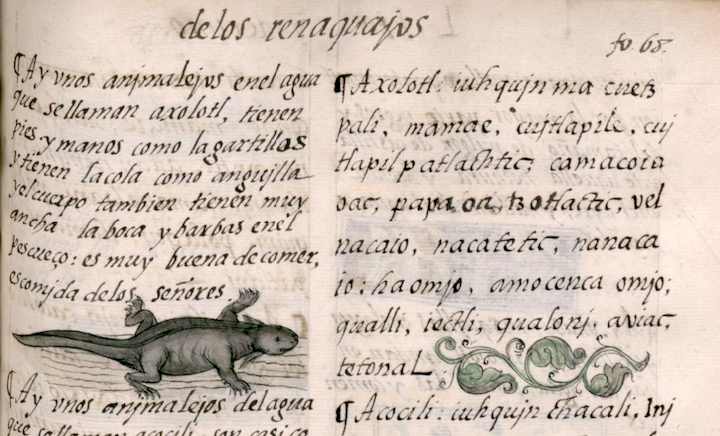Axolotl (FCbk11f241v)
This iconographic image is of an amphibian, a type of salamander called an (axolotl) found in the lakes of the Valley of Mexico. It appears on folio 241v (or 68r in the Digital Florentine Codex) in Book 11, “Earthly Things,” of the General History of the Things of New Spain, also known as the Florentine Codex. The salamander is drawn naturalistically from a 3/4 perspective or a modified bird's-eye view. The animal faces to the right and rests on lines that suggest its watery home. It is shaded in dark grays, giving it a three-dimensionality. The artist was careful to show its gills and the claws on its webbed feet, as well as its characteristic wide mouth, small eyes, a ridge running down its back and tail, and the rotund shape of its body.
Robert Haskett
The axolotl is described in Nahuatl by Sahagún’s Nahua co-authors as being “like the lizard, it has legs, it has a tail, a wide tail. It is large-mouthed, bearded. It is glistening, well fleshed, heavily fleshed, meaty. It is boneless--not very bony; good, fine, edible, savory: what one deserves.” The English translation is found in Sahagún, Fray Bernardino, General History of the Things of New Spain: Book 11 – Earthly Things. Translated and edited by Charles E. Dibble and Arthur J. O. Anderson. Salt Lake City and Santa Fe: The University of Utah, The School of American Research and the Museum of New Mexico, 1963, 64. For an interesting discussion of an axolotl by the San Diego Zoo, see https://animals.sandiegozoo.org/animals/axolotl. This animal has caught the imagination of children globally, partly owing to its appearance in video games, such as AK-xolotl and KinitoPET. Scientists are also fascinated by the animal’s regenerative abilities, such as being able to re-grow a foot if it is lost. There is hope that research into this aspect could lead to human applications. The English pronunciation is a far cry from the Nahuatl. The pronunciation should be: ah SHOW loat. The final letter “l” can be pronounced lightly when the next word in a sentence starts with a vowel. This is because the “tl” ending on many Nahuatl words is a fricative, not a vocative. In other words, it is not voiced, just a sound made by blowing air through tongue touching the upper teeth.
Robert Haskett and Stephanie Wood
Axolotl
axolotl
Robert Haskett
1577
Robert Haskett
salamanders, salamandras, animales
axolo(tl), a type of salamander, https://nahuatl.wired-humanities.org/content/axolotl
el ajolote
Robert Haskett
Library of Congress, https://www.loc.gov/item/2021667856/.
The Library of Congress is unaware of any copyright or other restrictions in the World Digital Library Collection. Absent any such restrictions, these materials are free to use and reuse. Researchers are encouraged to review the source information attached to each item. If you do publish anything from this database, please cite the Visual Lexicon of Aztec Hieroglyphs.



